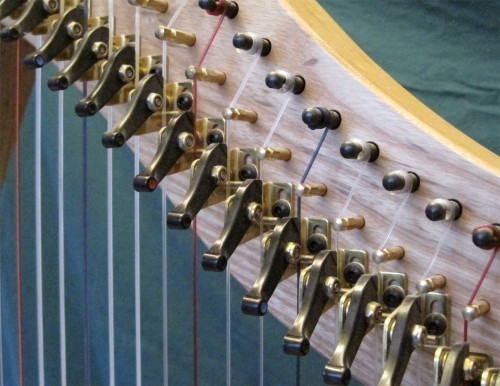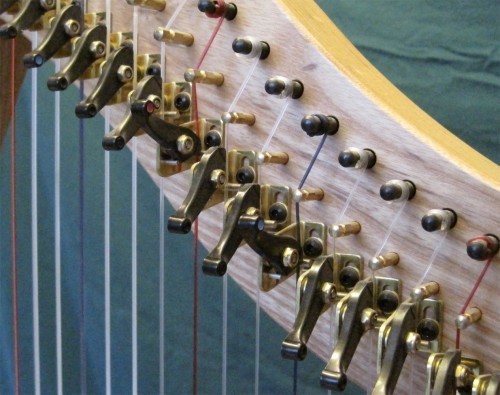Of Daydreams and Harps, Part 1: Guest post by Bratsche
Stringed instruments have been part of my life for a long time. I started violin at age 6, switched to viola in high school, and have been happily focused on viola ever since. The only other instruments that have ever enticed me to try them are also stringed instruments. I love the sound of guitars and harps. We had guitars in the house when I was a teenager, so I was able to play around with them; but I quickly found that the hand/arm position required for guitar put unacceptable stress on my viola playing arm.* I will always love listening to guitars, but that is the closest our acquaintance will ever be.
Over the years, I found myself starting to daydream about getting a small harp, but it was always a “someday maybe…” kind of thought. In the fall of 2010 I was talking to a violinist friend of mine and mentioned that in passing, and she immediately said, “Oh, yes, you should absolutely go for it!” She told me that a harpist colleague of ours (I’ll call her Jane) would be delighted to give me information and advice. I tucked that idea in with the daydream and left it at that.
The next spring, two things happened in quick succession. I got enough gift money from family to make me pause to think about what to do with it (as opposed to just enough to buy a book or CD or go to a movie), and I ran into Jane at a gig. I told her what I was thinking, and she was absolutely delighted to help. My daydream suddenly vaulted out of the shadows and took off!
I was initially thinking of a lap harp, which is the smallest kind of harp, since I figured smaller would probably equal cheaper (and any harp would require money from our regular budget in addition to my birthday money). Jane pointed out that if I started on a lap harp I would have to learn how to hold it at the same time I was learning how to play; whereas if I got a harp that could stand on the floor, I wouldn’t have to deal with that. She also said I might prefer the bigger range of a floor harp (as opposed to a lap harp). She gave me information about some lap harps (as well as the name of someone who knows more about them than she does) and also gave me the name of a harp store that makes what she considers to be a very good entry level floor harp.
After considering Jane’s advice, I decided to go for a floor harp. I went to a local harp store (where all the harps are way beyond my budget) to plink a few notes just to make sure it still sounded like a good idea once I’d actually had my hands on a harp. The answer was an emphatic yes (which elicited an eye-rolling “of course!” from my husband), so I made plans to drive the three hours to Dusty Strings (Jane’s strongly recommended harp store) to further explore this crazy dream.
A few pieces of basic harp information will help at this point. There are two broad categories of harps – pedal harps and other harps. Pedal harps are the big harps you might have seen in a symphony orchestra. They have 47 strings covering a range of 6.5 octaves (pianos have a range of just over 7 octaves) and use pedals at the base of the harp to play the sharp or flat notes as needed. There are lots of names and styles of harps which I’ve lumped into the second category: lever, lap, folk, and Celtic are some of the common terms. A lever harp uses levers up at the top of the harp to change the pitch by a half-step. It is not as easy to change notes on a lever harp as it is on a pedal harp, although it allows more variety of music to be played than a non-lever harp, which cannot change notes during a piece.

All levers down

Two levers up (red & blue strings)
I had already ruled out getting a lap harp, so my next decision needed to be about the size of the harp and whether or not it had levers. Dusty Strings has an entry level harp (i.e. cheapest harp I could get from them) called the Ravenna, which has two size options and several lever options. The smaller version has 26 strings (3.5 octaves), and the larger has 34 strings (4.5 octaves). The bigger harp goes an extra octave lower. The lever options include no levers, levers on just a few notes, or full levers (levers on every note). Size of harp and number of levers both affect the price.
As soon as I plucked the lowest note on the 34 string Ravenna, I knew I was in love.** I asked if there were any Ravennas available for rental and was told they did have a Ravenna 34 on hand (a somewhat rare occurrence, since they are very popular). It was fortunate that I had brought my husband and another friend of mine with me, because they were both very emphatic that I should jump on the chance to rent the harp and try it for a month or two. I might have dithered and talked myself out of the expense of renting the harp without their encouragement. Instead, we loaded the harp into the back of our car (having brought our bigger car just in case….) and headed home.
- – - – - – - – - – -
* A guitarist colleague of mine told me that he loved the sound of the viola so much that when he was in college he spent some time learning viola (his main instrument was guitar); but, he had to give it up in the end, because playing viola stressed his guitar arm too much. It was fun to have my assessment confirmed from the other side of the equation!
** The last time I had the same immediate (expensive) reaction was the first time I played the lowest string on my current viola. I give my students some very sound^ advice…do not play any instrument you do not intend to (or cannot afford to) buy. That way you won’t fall in love with something from which you must walk away. It is very good advice, but I’m still glad I ignored it 11 years ago when my viola maker asked me if I wanted to try out his latest viola! I was, however, VERY GOOD at Dusty Strings and didn’t even touch any of their more expensive harps.
^ !! :)
Robin McKinley's Blog
- Robin McKinley's profile
- 7240 followers



